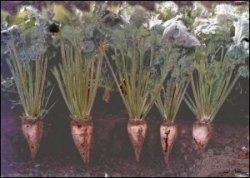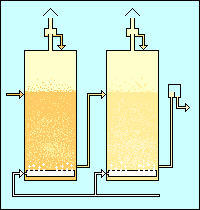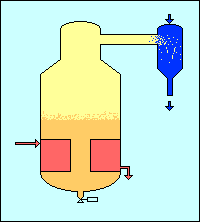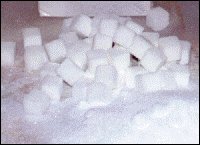How Beet Sugar is Made - the Basic Story
White beet sugar is made from the beets in a single process, rather than the two steps involved with cane sugar.
Harvesting
The beets are harvested in the autumn and early winter by digging them out of the ground. They are usually transported to the factory by large trucks because the transport distances involved are greater than in the cane industry. This is a direct result of sugar beet being a rotational crop which requires nearly 4 times the land area of the equivalent cane crop which is grown in mono-culture. Because the beets have come from the ground they are much dirtier than sugar cane and have to be thoroughly washed and separated from any remaining beet leaves, stones and other trash material before processing. |  |
Extraction
The processing starts by slicing the beets into thin chips. This process increases the surface area of the beet to make it easier to extract the sugar. The extraction takes place in a diffuser where the beet is kept in contact with hot water for about an hour. Diffusion is the process by which the colour and flavour of tea comes out of the tea leaves in a teapot but a typical diffuser weighs several hundred tons when full of beet and extraction water. The diffuser is a large horizontal or vertical agitated tank in which the beets slices slowly work their way from one end to the other and the water is moved in the opposite direction. This is called counter-current flow and as the water goes it becomes a stronger and stronger sugar solution usually called juice. Of course it also collects a lot of other chemicals from the flesh of the sugar beet. |  | |  |
Pressing
The exhausted beet slices from the diffuser are still very wet and the water in them still holds some useful sugar. They are therefore pressed in screw presses to squeeze as much juice as possible out of them. This juice is used as part of the water in the diffuser and the pressed beet, by now a pulp, is sent to drying plant where it is turned into pellets which form an important constituent of some animal feeds. |  | |  |
Carbonatation
The juice must now be cleaned up before it can be used for sugar production. This is done by a process known as carbonatation where small clumps of chalk are grown in the juice. The clumps, as they form, collect a lot of the non-sugars so that by filtering out the chalk one also takes out the non-sugars. Once this is done the sugar liquor is ready for sugar production except that it is very dilute.
The next stage of the process is therefore to evaporate the juice in a multi-stage evaporator. This technique is used because it is an efficient way of using steam and it also creates another, lower grade steam which can be used to drive the crystallisation process. |  | |  |
Boiling
For this last stage, the syrup is placed into a very large pan, typically holding 60 tons or more of sugar syrup. In the pan even more water is boiled off until conditions are right for sugar crystals to grow. You may have done something like this at school but probably not with sugar because it is difficult to get the crystals to grow well. In the factory the workers usually have to add some sugar dust to initiate crystal formation. Once the crystals have grown the resulting mixture of crystals and mother liquor is spun in centrifuges to separate the two, rather like washing is spin dried. The crystals are then given a final dry with hot air before being packed and/or stored ready for despatch. |  | |  |
Product
The final sugar is white and ready for use, whether in the kitchen or by an industrial user such as a soft drink manufacturer. As for raw sugar production, because one cannot get all the sugar out of the juice, there is a sweet by-product made: beet molasses. This is usually turned into a cattle food or is sent to a fermentation plant such as a distillery where alcohol is made. It does not have the same quality smell and taste as cane molasses so cannot be used for rum production. |  |
Power
One of the big differences between a beet sugar factory and its cane sugar counterpart is with respect to energy. Both factories need steam and electricity to run and both have co-generation stations where high pressure steam is used to drive turbines which produce the electrical power and create the low pressure steam needed by the process. However the beet factory does not have a suitable by-product to use as fuel for the boilers, it has to burn a fossil fuel such as coal, oil or gas. This is partly because the pulp will not burn properly and partly because the animal feed business has been built from the availability of the pulp. |  | |  |


|